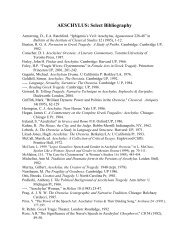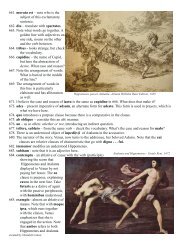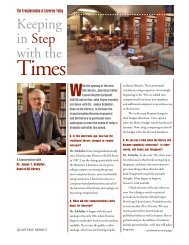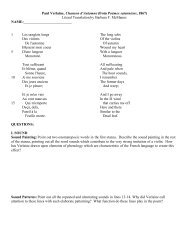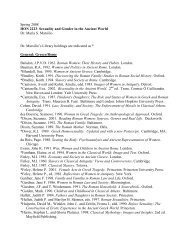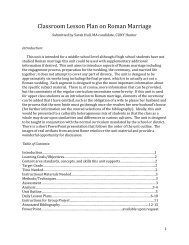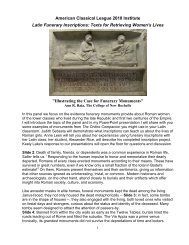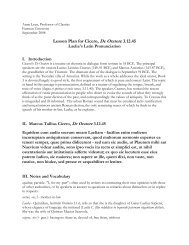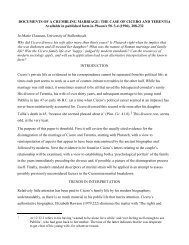You also want an ePaper? Increase the reach of your titles
YUMPU automatically turns print PDFs into web optimized ePapers that Google loves.
Katie Phillips<br />
Dr. A. Leen<br />
Latin 202<br />
Furman University<br />
4 December 2009<br />
<strong>Funerary</strong> <strong>Tablet</strong> <strong>for</strong> <strong>Cornelia</strong> <strong>Frontina</strong><br />
(C I L 6.10164)<br />
Description of the monument:<br />
The tablet is of white marble, simply adorned by a broad raised frame which surrounds the<br />
inscription on four sides. The lines are evenly spaced, the letters deeply incised Roman capitals.<br />
The first four lines are given prominence by their size and the separation of words, accented by<br />
medial dots (interpuncts). These lines contain the dedication, the name of the deceased, her age,<br />
and the name of her father, complete with his title as an imperial libertus. The remaining lines of<br />
the inscription contain words carved in small capitals without any separation, strategies<br />
employed by the stonemason to enable the inclusion of all of Callistus's text. The skill of the<br />
carver, the length of the inscription and the quality of the stone are evidence that the tablet was<br />
made <strong>for</strong> a family of some means and status among the freed class. The tablet is dated to the<br />
early 2nd century CE by the extended tail of the Q, characteristic of inscriptions of the early<br />
empire, and by Callistus’ citizen name, which narrows the date to Trajan’s reign (98-117 CE).<br />
The tablet was found on the Appian Way, near the tomb of Titus Flavius Pomponius, and is now<br />
in Rome at the Museo Nazionale Romano: Terme di Diocleziano. The tablet was affixed<br />
probably to a wall in a family tomb or columbarium that contained the family's cinerary urns.<br />
Marcus Ulpius Callistus and Flavia Nice, his wife, dedicated this tablet upon the death of his<br />
daughter, <strong>Cornelia</strong> <strong>Frontina</strong>. Callistus, commander of the Armory of the Ludus Magnus, the<br />
largest training school <strong>for</strong> gladiators in Rome, was manumitted under the Emperor Marcus<br />
Ulpius Traianus. Nice, whose nomen indicates she was freed by the gens Flavia, is not named as<br />
the mother (mater) of <strong>Frontina</strong>, whose freed nomen is different; thus Nice was probably not the<br />
biological mother of <strong>Frontina</strong>, who was likely born into slavery and freed by a member of the<br />
gens <strong>Cornelia</strong>. The tablet is both a testament to the life of <strong>Frontina</strong> and a mark of Callistus' pride<br />
in his status as an imperial freedman, in his authority over the gladiatorial weapons storehouse,<br />
and in the financial success that enabled him to own and free slaves of his own and to provide<br />
them and their dependents with precious burial space.
http://www.vroma.org/images/raia_images/inscription_frontina.jpg<br />
Transcription of the inscription:<br />
DIS • MANIBVS<br />
CORNELIAE FRONTINAE<br />
VIXIT • ANNIS • XVI • M[ensibus] • VII<br />
M[arcus] • VLPIVS • AVG[usti] • LIB[ertus] CALLISTVS<br />
PATER PRAEPOSITVS ARMAMENTARIO<br />
LVDI MAGNI ET FLAVIA NICE CONIVXS<br />
SANCTISSIMA FECERVNT SIBI<br />
LIBERTIS LIBERTABVSQ[ue] POSTERISQ[ue] EOR[um]<br />
[hoc monumentum]<br />
Translation of the inscription:<br />
To the Divine Shades<br />
of <strong>Cornelia</strong> <strong>Frontina</strong><br />
She lived <strong>for</strong> 16 years and 7 months<br />
Marcus Ulpius Callistus, freedman of the emperor,<br />
her father, Commander of the Armamentarium of the Ludus Magnus,<br />
and Flavia Nice, his most pious wife,<br />
made [this monument] <strong>for</strong> themselves,<br />
their freedmen and freedwomen, and <strong>for</strong> their descendants
Lexical and Interpretive Commentary:<br />
Line 1:<br />
Di Manes: The spirits of the dead, the divine spirits. By the end of the first century BCE, the phrase<br />
was common used as a heading tombstones until the end of the 2nd century CE.<br />
Line 2:<br />
<strong>Cornelia</strong> <strong>Frontina</strong>: it is noteworthy that her name does not m a t c h her father's, which indicates<br />
that she was born when her parents were slaves and came into the ownership of a member of the<br />
<strong>Cornelia</strong> gens.<br />
Line 3:<br />
m[ensibus]: a common abbreviation f o r m e n s i , s mensis m. month.<br />
Line 4:<br />
M[arcus] Vlpivs Callistvs: <strong>Cornelia</strong>’s father has the three names o f a Roman citizen. As is<br />
customary with freedmen, he added the praenomen and nomen of his <strong>for</strong>mer m a s t e to r his slave<br />
cognomen upon manumission by the emperor Trajan, whose full name was Marcus Ulpius<br />
Traianus.<br />
Avg[usti] Lib[ertus]: a common abbreviation <strong>for</strong> imperial freedmen.<br />
Line 5:<br />
praepono, preponere, praeposui, praepositus: place in command, in front of or be<strong>for</strong>e; the<br />
perfect passive participle isused here as a substantive noun and can there<strong>for</strong>e be translated as<br />
Commander or Overseer.<br />
Armamentarium, armamentarii: n. armory, storehouse <strong>for</strong> military equipment. Callistus’<br />
position as commander of the armory, where weapons <strong>for</strong> the gladiatorial games were kept,<br />
repaired, and maintained, was a prestigious one.<br />
Line 6: l<br />
Ludus Magnus: the largest gladiatorial school and barracks in Rome, it was attached by an<br />
underground walkway directly to the Colosseum.<br />
Flavia Nice: her nomen derives from her manumission by a m e m b e r of the Flavian gens; since<br />
Trajan's reign began 43 years after the death of Domitian, the last of the Flavian emperors, it<br />
was not one of the imperial family. Her s l a v cognomen, e Nice, suggests her Greek origins.<br />
ConIuxs: note the omission of "n," the enlarged ‘I’to indicate a long vowl and the final ‘s’; this<br />
spelling is o f t e n found on tombstones, which preserve common pronunciation.<br />
Line 7:<br />
fecerunt: I added the understood “hoc monumentum” to complete the phrase.<br />
Line 8:<br />
libertabusque posterisque: a common abbreviation <strong>for</strong> the suffix ‘que’ is a simple ‘q.’<br />
Eor[um]: an abbreviation dictated by the lack of space on the line.
Works Cited<br />
"Augustus" A Dictionary of First Names. Patrick Hanks, Kate Hardcastle, and Flavia Hodges.<br />
Ox<strong>for</strong>d University Press, 2006. Ox<strong>for</strong>d Reference Online. Ox<strong>for</strong>d University Press.<br />
Furman University. 6 December 2009<br />
.<br />
Elliott, Tom. "Abbreviations in Latin Inscriptions." Abbreviations in Latin Inscriptions. Case<br />
Western Reserve University, 1998. Web. 6 Dec. 2009.<br />
.<br />
"Flavian emperors" The Concise Ox<strong>for</strong>d Companion to Classical Literature. Ed. M.C. Howatson<br />
and Ian Chilvers. Ox<strong>for</strong>d University Press, 1996. Ox<strong>for</strong>d Reference Online. Ox<strong>for</strong>d<br />
University Press. Furman University. 6 December 2009<br />
<br />
Harvey, Brian K. Roman Lives: Ancient Roman Life As Illustrated by Latin Inscriptions.<br />
Newburyport, MA: Focus Pub./R. Pullins Co, 2004.<br />
John Brian Campbell "Trajan (Marcus Ulpius Traianus)" The Ox<strong>for</strong>d Classical Dictionary.<br />
Ed. Simon Hornblower and Anthony Spaw<strong>for</strong>th. Ox<strong>for</strong>d University Press 2009. Ox<strong>for</strong>d<br />
Reference Online. Ox<strong>for</strong>d University Press. Furman University. 6 December 2009<br />
<br />
Lewis, Charlton T., and Charles Short. A Latin Dictionary. Ox<strong>for</strong>d: Clarendon, 1879. Perseus<br />
Digital Library. Tufts University. Web. 6 Dec. 2009.<br />
Riley, Henry T. A Dictionary of Latin and Greek Quotations, Proverbs, Maxims and Mottos,<br />
Classical and Mediæval Including Law Terms and Phrases. New York: Adamant Media<br />
Corporation, 2004. Google Books. 6 Dec. 2009 .<br />
Trajan's Rome: The Man, The City, The Empire. University of Cali<strong>for</strong>nia, Los Angeles. Web.<br />
6 Dec. 2009. .



